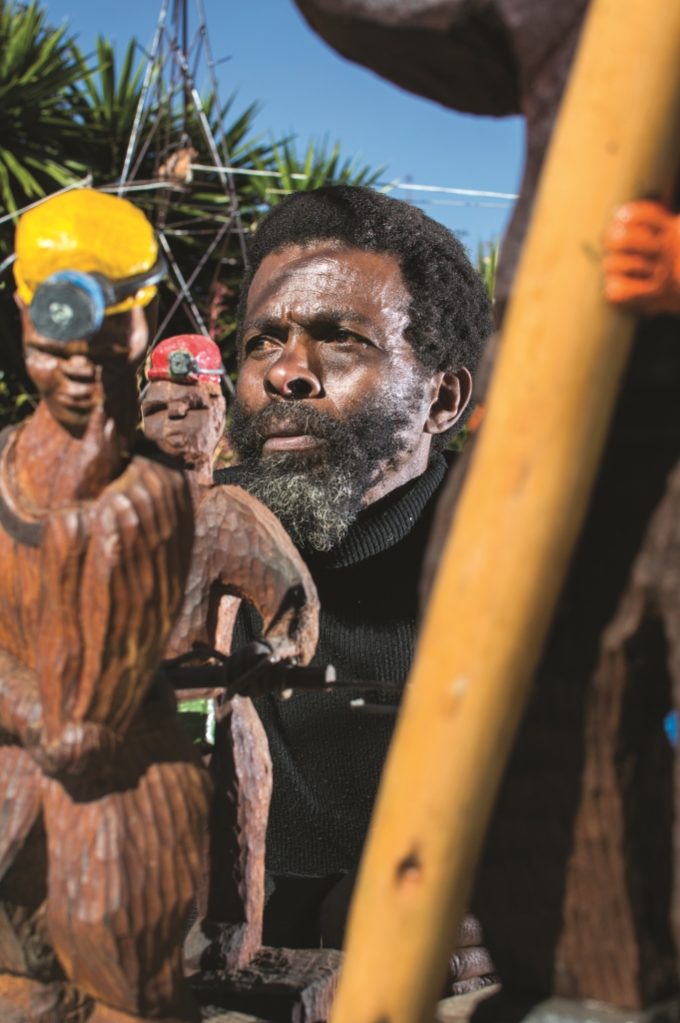In his lifetime, Vincent van Gogh created 900 paintings and 1,100 drawings and sketches, but only ever sold one painting, a few months before his death. A century later, a song has been written about him; a museum dedicated to his work; and cafes are covered with his signature blue and yellow pieces. Van Gogh would have probably enjoyed a few stories over beers with Louis Chamane. In 20 years of sculpting, after 11 years of sweating and working his fingers to the bone in the mines, living hand to mouth and relying on his wife as the bread winner – Chamane has just made his first sale late in life.
His face is hardened by the years of toil but he has a cheeky grin as he tells his story. Chamane traveled to ‘Egoli’– the city of gold as Johannesburg is known – in the 1980s. He worked as a lasher and later as an electrician; it’s grueling work underground. Egoli’s fortune wasn’t his by 1995, he was one of hundreds of miners from rural KwaZulu-Natal who were retrenched.

“I enjoyed mining. When they retrenched me I was so cross. I thought they would call me again, but nothing. All the people from KwaZulu-Natal, they didn’t want them here in Transvaal (the old name for Gauteng) anymore,” he says.
He poured his anger and frustration into sculpting a series that tells a story of the goldmines – tracing every aspect meticulously. The Mineworkers Investment Company (MIC) celebrated 20 years by paying tribute to South Africa’s fallen mineworkers with his collection, which will be permanently displayed at Constitution Hill in Johannesburg. It hasn’t been easy.
Loading...
A solid block of wood carved into figures of miners is given life with clay, rock, chains, wire and tubing. Chamane is a man of few words but his sculptures speak volumes.
“The story of the sculptures is the underground. The theme of these works is ‘abasebenzi’ (workers). The helmets are different colors. It’s not decorative, I’m showing the different work. The yellow is the shaft department, the red is the electrician, fitting, rigor, blue is lashing, white is team leader,” he says.
“I’ve decided to stick with the mine. Because I know exactly what happens underground, if I stick with the underground, I tell people something that I know. It’s not imagination, it’s based on my life.”
On a hill, overlooking the whole of Johannesburg, in the heart of the city – Constitution Hill Precinct is one of the city’s heritage sites. As the country transformed post-apartheid, the precinct signified the change. An old prison, where Mandela and Gandhi were jailed, became the site for the Constitutional Court and three museums. While the court boasts an art collection, that could rival the Tate Modern, Chamane’s sculptures are just the start of a large permanent collection.
“I’ve never been to Constitution Hill before. I don’t know this place. You can see the whole city from here,” he says timidly.
He taught himself how to sculpt by watching his father and learning from other artists. In spite of his hardship, Chamane is finally living out his dreams.
“I was an artist before I was a miner. Not professionally, naturally,” he says proudly.
“What I like so much in art is that you do what you feel. If I’m asked to do something and if I do something that I feel – it can never be the same,” he says.
He’s one up on Van Gogh with an exhibition, but it’s just the start of a legacy that the Dutch painter probably would have taken an afternoon to view.
Loading...
